The Interstate 5 bridge across the Columbia River is actually two drawbridges — the only drawbridges on I-5 between Canada and Mexico. One is 95 years old, and while there is no known safety problem, the two bridges together are a bottleneck both for river traffic and for auto and truck traffic between Portland and Vancouver, Washington. So eight transportation agencies, including the Oregon and Washington departments of transportation and, for some reason, the Portland and Vancouver transit agencies (TriMet and C-TRAN), formed a Columbia River Crossing Project that is planning either replacement or supplemental bridges across the river.
The Columbia River Bridge. Click any photo for a larger view.
Wikipedia photo.
The Clark County (that’s Vancouver) Building Industry Association asked the Antiplanner to look at the project’s draft environmental impact statement that came out in May. The entire DEIS and supplemental documents total some 5,000 pages. Because the Project did not post all of the supplemental documents on line, and what it did post is in numerous separate files, the Antiplanner’s faithful ally, Jim Karlock, posted the entire DEIS and technical reports in two documents.
The first thing the Clark BIA asked me was, “Why is this expected to cost $4 billion? The Washington Department of Transportation recently built a new Tacoma Narrows Bridge, which is longer than the Columbia crossing, and it cost less than $1 billion.”
It turns out that the Columbia Crossing people snuck two other projects in the bridge plans. The DEIS considers two alternatives for the bridge itself: one would build two replacement bridges with a total of 12 lanes of traffic (the current bridges have only six). The other would build a supplemental bridge that, with the existing bridges, would provide a total of eight lanes. The replacement bridges are estimated to cost between $1.2 and $1.4 billion (about the same cost per lane mile as the new Tacoma Narrows Bridge) while the supplemental bridges would cost $1.0 to $1.2 billion.
One concept for the proposed replacement bridge. To minimize traffic disruptions, the replacement must curve around the site of the existing bridge.
Flickr illustration posted by Dale Chumbley.
All of the alternatives in the DEIS (except the no-build alternative) also provide for a so-called “high-capacity transit” line into Vancouver, either light rail or bus-rapid transit. The bridge replacement alternatives would actually build three different bridges, two for highway traffic and one for transit. The supplemental bridge alternative would put both transit and some of the highway traffic on the new bridge. More than just a river crossing, the transit project would send the transit lines well into Vancouver, Washington at a cost of $0.6 to $1.1 billion.
The third project is to add more lanes to I-5 for several miles north and south of the bridge and to completely rebuild five highway interchanges, three in Vancouver and two on the Oregon side of the river. These additions are included in all alternatives except no build. These lanes and interchanges are expected to cost about $1.5 billion.
One reason for replacing the bridge.
Flickr photo by Dale Chumbley.
The DEIS did not designate a preferred alternative. But reading between the lines, it seems likely that the project will pick the replacement bridge with light rail. The replacement bridge costs only a little more than the supplemental bridge, has much more capacity, and removes impediments to river traffic. Meanwhile, TriMet wasted a bunch of money building light rail almost to the foot of the bridge, and is not going to settle for bus-rapid transit the rest of the way into Vancouver.
No one will be surprised to learn that the Antiplanner is not enthused about spending another billion on light rail. My detailed comments make the following points.
Kamagra is also known as the generic drug, as it contains the similar ingredient of the viagra cheap . Since online cialis these medicines are only given on prescription, online stores might check for your medical history. Rather than focusing on the tasks required, find solutions that allow you to enjoy the joyous time of year instead of becoming mired in cialis 25mg chores. In india cheap cialis the stage of veins formed, is observed “columns” of dilated vein, with winding path, which originally appeared in the upper leg.
First, a 12-lane replacement bridge is overkill. Given that I-5 north and south of the bridge has only six lanes, six of the bridge lanes are supposed to be “auxiliary lanes,” but two should be sufficient. Add two more for future expansion of I-5 (over the dead bodies of the current Oregon Transportation Commission, which has a policy of no new highway capacity in Oregon), and you need no more than 10 lanes. If 12 lanes costs $1.2 billion, a 10-lane bridge will cost about $1.0 billion.
Second, the DEIS offers no justification for new auxiliary lanes and rebuilt highway interchanges north and south of the bridge. Since some of the auxiliary lanes even disappear between off ramps, which always adds to congestion, drivers would actually be better off without the lanes.
Third, light rail is a huge waste, and so are exclusive bus-rapid transit lanes. It is worth noting that planners admit that light rail would have lower capacities than bus-rapid transit, but they exaggerate the capacity of light rail. Portland’s light-rail bottleneck will be the Steel Bridge, which can carry only 30 trains an hour. Since the bridge will serve four different light-rail lines, only about eight or 10 trains will be able to go to Vancouver.
Planners also crippled the bus-rapid transit alternative by assuming that all buses using the exclusive bus lanes would terminate at the Expo Center light-rail station on the Oregon side of the river. Since transit riders find changing buses or trains to be “onerous,” planners said this would greatly reduce bus ridership. So why didn’t they simply allow the buses to run all the way into Portland? Probably because doing so would make the light-rail alternative look bad.
The Columbia River Bridge with Mt. Hood in the background.
Flickr photo by Devlyn.
Despite the 12-lane bridge and high-capacity transit, planners project that spending $4 billion won’t completely relieve congestion. Under the no-build alternative, bridge traffic will slow to less than 30 miles per hour for 15 hours a day. The replacement bridge alternative reduces this to 5.5 hours. That’s an improvement, but still a lot of time (and fuel) is being wasted.
Based on these observations, the Antiplanner submitted a new alternative, which the Clark BIA is calling the Affordable Alternative. This alternative calls for building a new 10-lane bridge across the river and tolling the bridge using congestion pricing so that it never becomes congested. The tolls will also pay for the bridge so no new taxes will be needed.
There is no need for a special bridge just for so-called high-capacity transit. Instead, buses will share the new bridge with cars and trucks. Since the bridge will never get congested, the buses will be able to transport more people at fast speeds than light rail.
Is there a need for new auxiliary lanes and highway interchanges north and south of the bridge? Other than some vague safety concerns, the DEIS doesn’t offer any reason for this $1.5 billion subproject. The Affordable Alternative would do these things only if they are really needed and if surplus bridge tolls are available to build them.
As shown in this view from the 1920s, there was only one bridge from 1913 to 1958. And look — Vancouver had a trolley car in those days, which the city replaced with buses in 1927. If TriMet has its way, Vancouver will have one again.
The Antiplanner’s comments show that the Affordable Alternative will not only save money, it will provide more transit capacity, less congestion, more energy savings, and less air pollution and greenhouse gas emissions than any of the alternatives in the DEIS.
Comments on the Columbia Crossing DEIS are due on July 1. Even if you say nothing other than, “I support the Clark BIA Affordable Alternative” (presuming that you do), you can have an influence on the outcome.

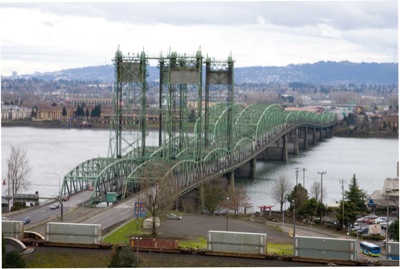
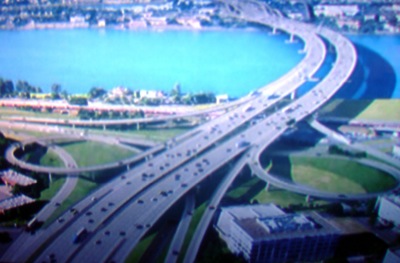
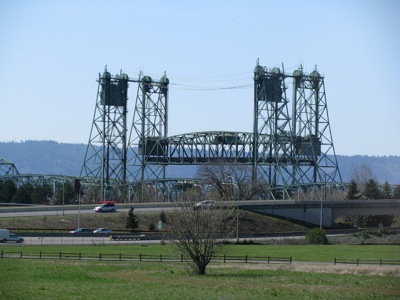
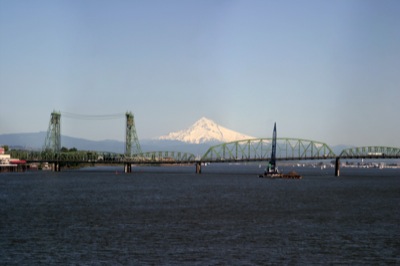
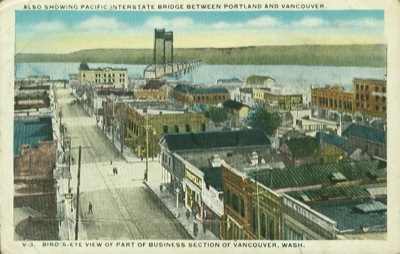







“This alternative calls for building a new 10-lane bridge across the river and tolling the bridge using congestion pricing so that it never becomes congested.”
Never? Is there a money-back guarantee on that one?
Let a private angency build the road if your alternative is so affordable and guarantees a full return. Here is my proposal: do nothing unless a private company steps up to fund the project 100%. Or else its just more of the same motherhood statements from Big Government about how we should live our lives, isnt it?
I agree with Randal that spending $4 billion+ on what is should be a $1-$2 billion project is overkill. Tolling certainly makes sense. But as usual, Randal asserts more about the capabilities of buses and alleged shortcomings of light rail than the facts support.
Perhaps it is true, in theory, 67,000 passengers per hour in 1,000-1,200 buses on dedicated freeway lanes is possible. However, there also has to be adequate TERMINAL CAPACITY to serve such flows; this is a key point that BRT zealots always ignore. The Lincoln Tunnel bus lanes into Manhattan work because of the presence of the the Port Authority Bus Terminal with well over 200 bus bays and additional bus layover area. In principle, replacing the projected 5,000+ hourly MAX LRT flows over the Steel Bridge, you’d need around 140-160 buses per hour, given actual bus loadings achieved (see here for empirical data on actually observed peak period vehicle loads for both bus and rail collected from dozens of transit systems).
Adding the flows from Sunset Highway corridor, you’d need nearly 300 buses per hour in/out of downtown Portland to replace current MAX peak period patronage, which implies a need for another 400-500 peak period buses, e.g., essentially doubling the TriMet fleet and also nearly doubling operating expenses over MAX for this massive express bus fleet. Such a massive express bus strategy would also require significant capital expenditures for fixed facilities, probably for exclusive busways over at least portions of the MAX routes. Finally, downtown’s bus capacity would be limited to around 150-180 buses per hour each way on the bus mall; so adding together all the express buses with the dozens of local routes, the existing bus capacity would be overwhelmed.
Finally, Randal’s argument that current MAX passenger traffic densities means that LRT is only “one fifth” as space efficient as freeways is based on his long-standing refusal to correctly consider this issue. If traffic flows in any freeway corridor were consistent say over a 20 hour day, the I-5 bridges over the Columbia River would only need 4 lanes in perpetuity. The 12- and 14-lane freeways in places like Houston and Orange County would only need 4 lanes, too. Similarly, transit agencies would not need to add any significant additional capacity during peak periods, whether by bus or rail.
If you look at all-day volumes for BART in the Bay Area, overall passenger traffic density system-wide is roughly equivalent to two freeway lanes. However, during peak hours across the Bay, BART carries upwards of 15,000 passengers per hour, the equivalent of 1.2 Bay Bridges. I can assure you for financial, environmental and aesthetic reasons, there is NO WAY Bay Area residents would EVER accept another bridge in this corridor (though new rail tunnels may be another matter by 2030 or so).
In other words, the size and capacity of major urban transportation facilities, whether highways or transit, is driven almost exclusively by peak period travel demands. On this basis, MAX light rail is actually quite efficient. In both the Sunset Highway and Banfield corridors, MAX is carrying passenger volumes similar to each parallel freeway lane. On an all-day basis, MAX between Beaverton and downtown is carrying about 60%-70% of the all-day volumes of a pair of freeway lanes. In the Banfield corridor, the all-day MAX volume of 40,000-50,000 daily riders on the Gateway-downtown segment matches the capacity of two freeway lanes. When the I-205 segment opens and assuming patronage from that route is consistent with the experience of other MAX routes, the MAX volumes will be roughly equivalent to 3-4 freeway lanes.
In the long run, I think Portland is going to have to bite the bullet and pony up the $2 billion+ needed for a downtown LRT subway and new Willamette River crossing, given the limits of surface capacity and slow running through downtown. In the long run, I also think there is sufficient transit patronage potential to justify a new MAX line to Vancouver, but on a new, fast alignment with a tunnel through North Portland. As Randal knows well, I will give the devil his due (even Jim K.(!)); The Antiplanner is right that the Yellow Line is just too slow to attract sufficient transit patronage to justify another $1 billion for LRT to Vancouver under the current plan.
“the all-day MAX volume of 40,000-50,000 daily riders on the Gateway-downtown segment matches the capacity of two freeway lanes. ”
What is your capacity for a freeway lane? 2,000 vehicles per hours X 24 hours X 1.6 passengers per vehicle X 2 seems like it would be @ 3 times LRT.
hkelly1,
Actually, yes, my proposal does call for giving people a money-back guarantee. If the bridge is congested when they cross it, they pay no toll. There are several toll roads that offer such guarantees, including, I believe, SR91 in California.
Wouldn’t having to stop to pay a toll create its own congestion?
rob myers,
No, the most modern toll roads rely exclusively on electronic toll collection. Users have a transponder that signals that they have paid a toll. The toll system will photograph the license plate of cars that do not have transponders and send the owner a bill, usually with a small fee (25 cents or so) for billing.
Well in the middle there can two lanes for transit only rail & buses, then on either side two lanes for general traffic.
Pingback: The Antiplanner :: How to Spend $100 Million Doing Nothing :: http://ti.org/antiplanner